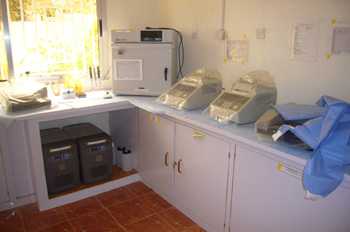Sierra Leone: A Symbol of a Healthier Future

Central Public Health Reference Laboratory for HIV and Other Infectious Diseases. The newly renovated molecular unit is providing HIV Early Infant Diagnosis PCR testing and HIV Viral Load testing.
Opening a laboratory is rarely accomplished in one year’s time. In a country like Sierra Leone, which is still recovering from a decade-long civil war, it is even more difficult. But over the past year, CDC, the Sierra Leone Ministry of Health, and a host of global health partners have managed to do just that.
Because of the country’s long civil war, U.S. Government programs are relatively new to Sierra Leone. “CDC’s first time in-country was January 2009,” explains Laura Shelby, a Global AIDS Program country officer who helps manage CDC’s public health work in Sierra Leone. “We decided to focus on where we could have a big impact.”
Public health laboratory and surveillance measures were priorities. So health organizations working in Sierra Leone banded together to create a reference laboratory that could serve all the country’s citizens.
“The first thing that happened was we developed a laboratory policy,” says Shelby. “This was done under the auspices of Ministry of Health technical work groups. It established country ownership from the get-go. Nothing was done outside of the Ministry of Health.”
“The development of a laboratory policy and strategic plan is the key to successful programs,” notes Dr. Marie-Claire Rowlinson, who manages Sierra Leone activities for APHL, which supported the laboratory renovations through a cooperative agreement with CDC and hired Dr. Isatta Wurie as a full-time laboratory consultant for the project. “Isatta helped create the National Laboratory Policy and Strategic Plan and was a real champion.”
Challenges quickly arose. Sierra Leone’s current reference laboratory had been performing some HIV testing, but primarily was being used as a warehouse to store medicine. It also had no water or power. So PEPFAR renovated a small storage space and moved the medicine offsite. “And that’s when the lab really started taking off,” Shelby says.
CDC helped connect the lab to the electrical grid, created a serology unit, and brought four laboratory scientists to Atlanta for training. UNICEF refurnished one of the old lab rooms into a molecular unit, and WHO created a microbiology unit. Within a mere 12 months, the new laboratory was testing samples. “I give UNICEF and WHO a lot of credit,” says Shelby. “They were great partners.”
Public health programs for treating and monitoring diseases such as tuberculosis, malaria, and HIV depend on strong, efficient laboratories. The new laboratory will allow Sierra Leone to test citizens for all of these diseases, instead of sending samples to other countries. “It is an amazing success,” says Dr. Rowlinson. “The lab has come a long way.”
“All our partners pooled their resources,” notes Dr. Thierry Roels, CDC-Sierra Leone country manager. “We would not have been able to accomplish this great feat if it weren’t for CDC’s strong collaboration with the Sierra Leone Ministry of Health and National AIDS Secretariat, and our enduring partnerships with WHO and UNICEF.”
- Page last reviewed: January 2, 2015
- Page last updated: January 2, 2015
- Content source:
Global Health
Notice: Linking to a non-federal site does not constitute an endorsement by HHS, CDC or any of its employees of the sponsors or the information and products presented on the site.


 ShareCompartir
ShareCompartir